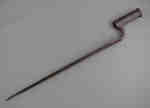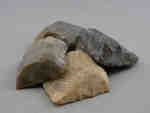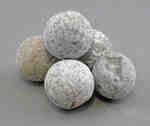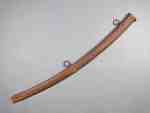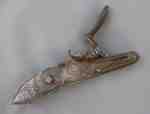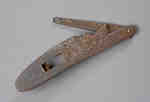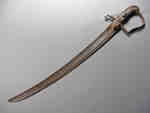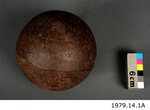Résultats
- This is a bayonet that would have been designed to fit on the muzzle of a rifle or musket. Unique markings include a crown with the inscriptions “40”, “WHEELER”, “O”, and a “V” on the front of the blThis is a bayonet that would have been designed to fit on …
- This bayonet would have been designed to fit on the muzzle of a Brown Bess musket. It is slightly bent at the tip and unique markings on the blade include: a crown with “31”, “I. Salter” and what looThis bayonet would have been designed to fit on the muzzle of …
- This is a black leather bayonet sheath that measures 37.5cm in length. There is also a frog clip that was used to mount it on a belt. Stamped into the sheath near the frog clip are the markings: “E”,This is a black leather bayonet sheath that measures 37.5cm in length. …
- This is a piece of flint that was unearthed at one of Niagara’s Battlefields. It would have been used to light a flintlock musket when firing at the enemy.This is a piece of flint that was unearthed at one of …
- A collection of musket balls found at one of Niagara's battlefield sites. Sizes range from 1.8 to 1.5 to 1.2 cms.A collection of musket balls found at one of Niagara's battlefield sites. …
- A scabbard with a gilt top was part of an infantry officer’s sheath, pattern 1796. It is black leather with gilt binding, frog clip and sash ring. The top gilt piece has become detached from the leatA scabbard with a gilt top was part of an infantry officer’s …
- A steel military scabbard that is curved with two metal bands with a ring attached to each. The metal is dull and rusty and the tip is broken off.A steel military scabbard that is curved with two metal bands with …
- A curved steel scabbard that is said to have been found on the Lundy's Lane Battlefield by W. W. Woodruff.A curved steel scabbard that is said to have been found on …
- A British Officer’s sword and scabbard. The scabbard is black leather with a brass tip and collar with a ring. The sword has an urn hilted pommel with a fixed guard and the hilt is wrapped with wire.A British Officer’s sword and scabbard. The scabbard is black leather with …
- A musket action with “TOWER”, a crown and the Royal cipher “GR” engraved on one side.A musket action with “TOWER”, a crown and the Royal cipher “GR” …
- A Brown Bess rifle, commonly called an India Pattern Musket, that has been previously converted from a flintlock to a percussion action. It is a single 39 inch barrel with three ram rod pipes. ThereA Brown Bess rifle, commonly called an India Pattern Musket, that has …
- This is a musket action piece that has ornate markings on one side. This item is currently on display at the Battleground Hotel Museum.This is a musket action piece that has ornate markings on one …
- These are cannon balls from the Battleground Hotel Museum.These are cannon balls from the Battleground Hotel Museum.
- These are remnants of a canister shot that is believed to be from one of Niagara’s Battlefields. This form of ammunition, also referred to as a grape shot, was fired at an angle from a cannon and relThese are remnants of a canister shot that is believed to be …
- A sword believed to have been unearthed at one of Niagara’s Battlefields. Inscriptions include “HADLEY” with three circles (near the handle) and “4” with a crown on the blade. The grip of the handleA sword believed to have been unearthed at one of Niagara’s Battlefields. …
- This is a remnant of the tip of a bayonet sheath which can be found at the Battleground Hotel Museum.This is a remnant of the tip of a bayonet sheath which …
- These are various pieces of a musket action that were unearthed at one of Niagara’s Battlefields. These items are on display at the Battleground Hotel Museum.These are various pieces of a musket action that were unearthed at …
- The origin of the sword is unknown and there are no distinct markings on it. It is believed however, that the sword would have been carried by the Light Cavalry (Light Dragoons and the Hussars). TheThe origin of the sword is unknown and there are no distinct …
- A cannonball of this type would have been used during the War of 1812. This brown, iron cannonball is 16 inches in circumference and approximately 5 inches in diameter. The surface is of the cannonbaA cannonball of this type would have been used during the War …







